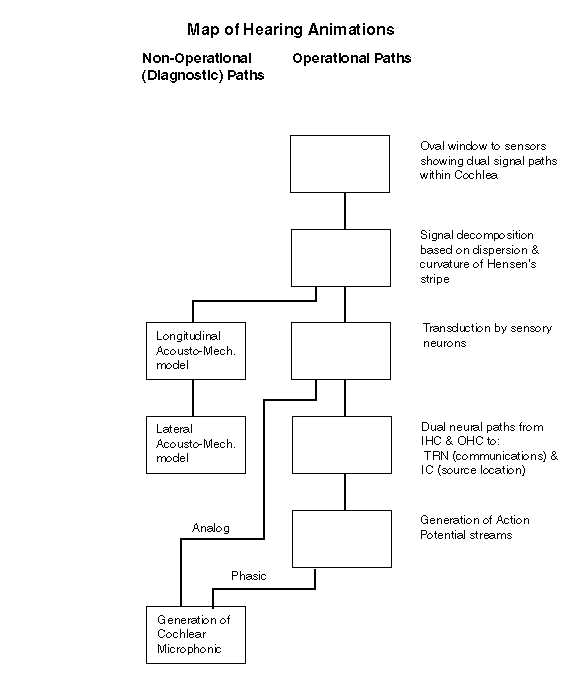
Hearing Explained using Animation
based on the
SAW-based Electrolytic Theory of Hearing
Last Update 15 Jul 09
Activa™: See Citation Page
Introduction
This page addresses how humans and other animals (mammals, birds, reptiles and monotremes) hear. While the following animations are observable by any age group, understanding the process requires varying degrees of background. The underlying theory is presented for the benefit of the graduate level community. Advanced college students, following Introductory Biology, will find the material challenging but the references provided should lead to more detailed explanations. Very advanced students in grades 11-12 can be challenged by the work.
The following animations are provided in three groups according to the following figure. Each can be addressed individually using the hypertext. Within each animation of the set, navigation keys are also provided. They provide forward, backward navigation among the animations related to the operational aspects of hearing. At some points, sideways navigation is provided to the diagnostic (but generally pathological) animations. Sideways navigation is also provided to a set of dynamic mechanical models describing the internal operation of the cochlea.
The animations were prepared using version 2.0 of Animation Shop, provided bundeled with JASC Paint Shop Pro, version 6.0.
List of Available Animations
The following list is being implemented as time allows. Where only a non-hypertext title is given, no animation has been prepared. The reader may want to query the author concerning the availability of such an animation.
Section I: The basic set of hearing animations.
- A physical model of how acoustic energy is converted to a surface-acoustic-wave in the vestibule of the labyrinth
- A schematic of acoustic energy propagating along the cochlear partition
- How the energy is divided into tonal and temporal channels during propagation down the cochlear partition
- How the tonal energy is separated into individual frequency componets during propagation down the cochlear partition
- How the extracted energy is used to create an electrical signal within a sensory neuron
- How the extracted electrical signals proceed up the nervous system
- Primary Signal Paths of Hearing, both peripheral and within the Central Nervous System
- How the extracted electrical signals are used for source location
- How the extracted electrical signals are used for simple speech recognition
Section II The Available set of Animated Dynamic Structural Models.
- The Longitudinal Acousto-Mechanical model of the cochlear partition.
- The Lateral Acousto-Mechanical model of the cochlear partition
Section III The Available set of Diagnostic animations.
- Generation of the Cochlear Microphonic
Roadmap to the Available Animations (Incomplete at Present)

Return to the hearing website home page.
Copyright © 2005 James T. Fulton

